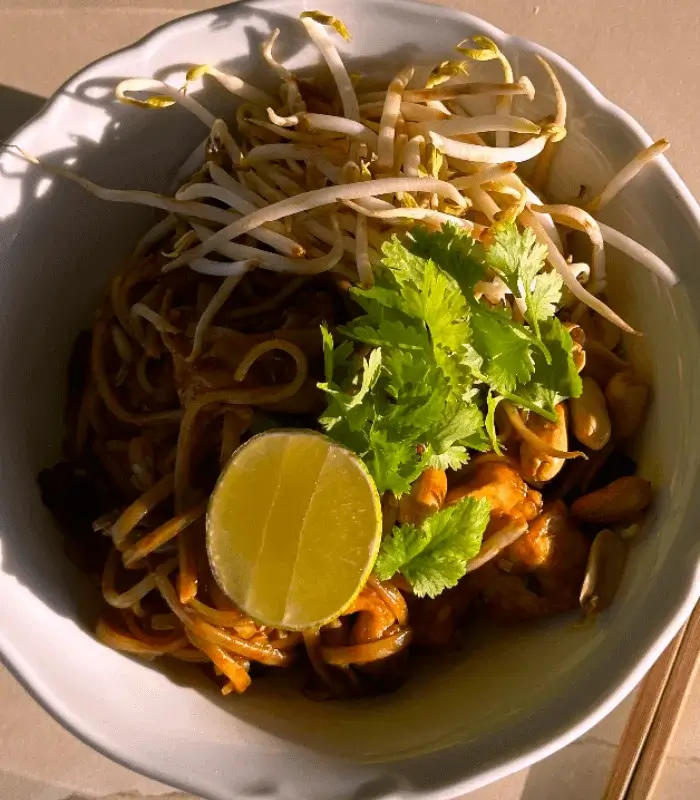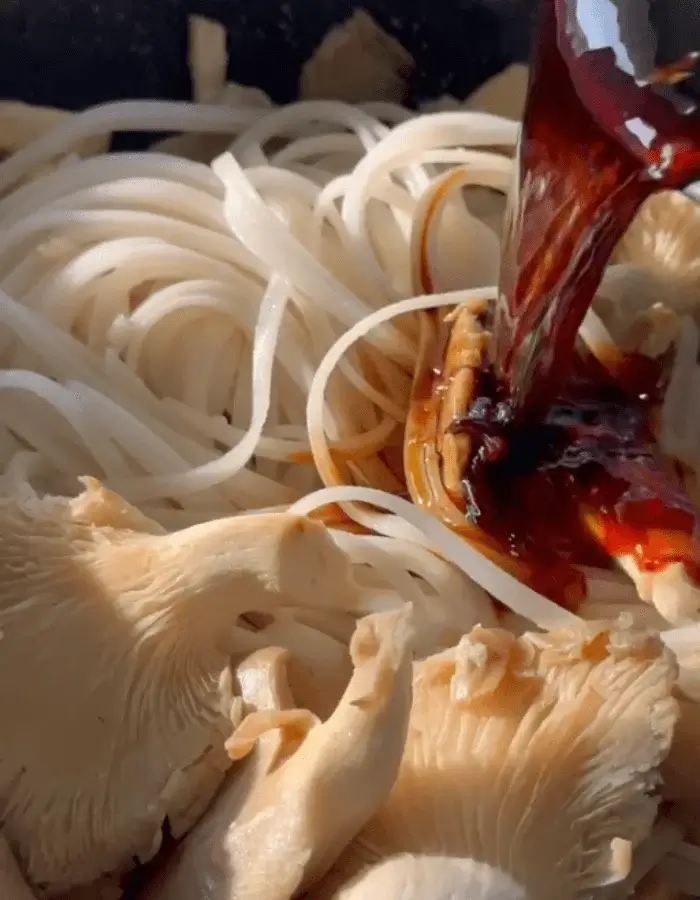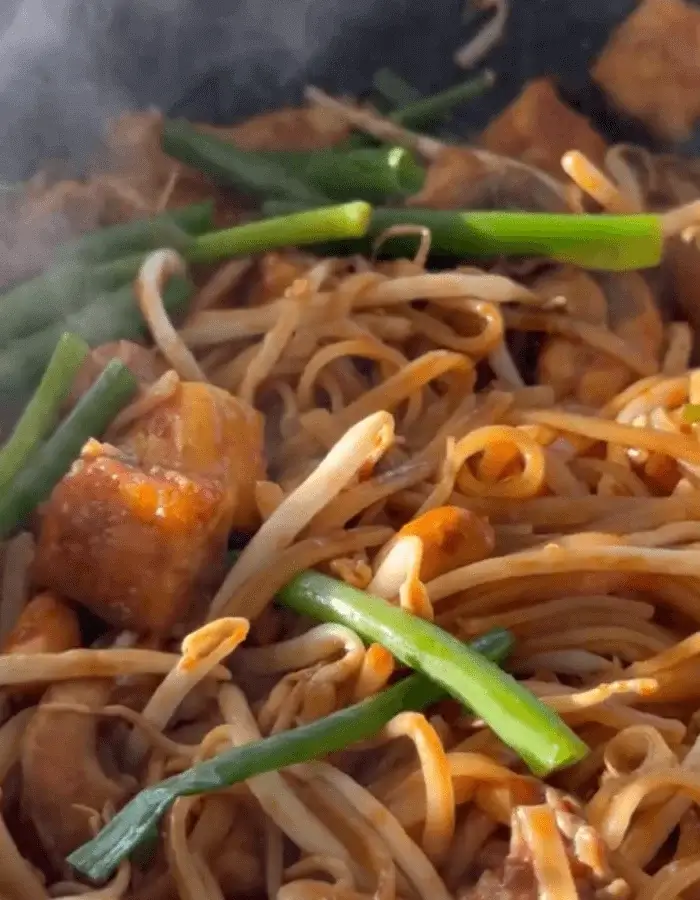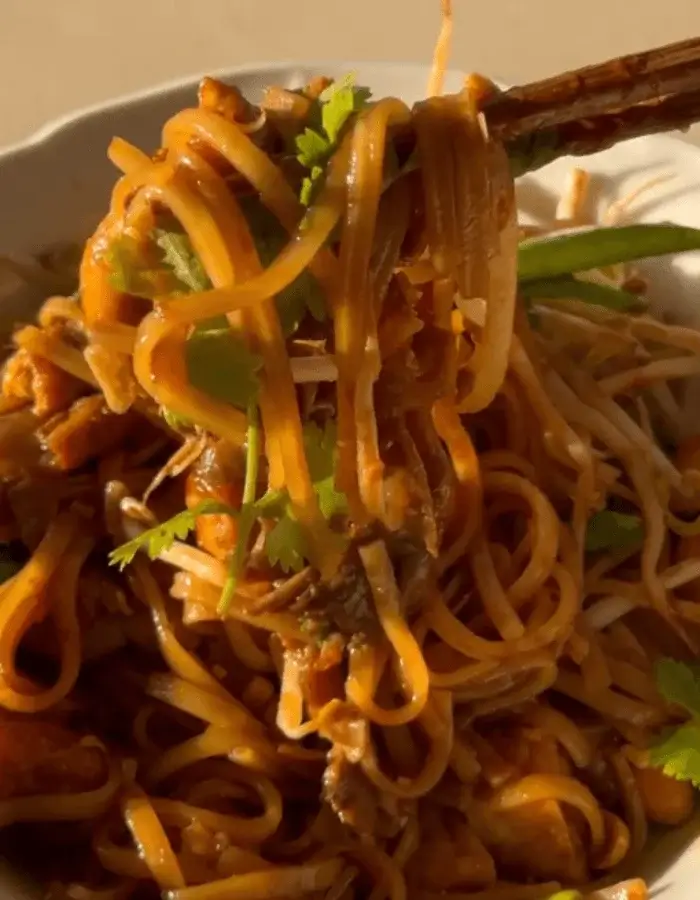Tofu Pad Thai with Lemongrass Sauce
We may earn a commission from recommended products, at no extra cost to you. See Disclosure.
INGREDIENTS
- 4.4 ounces/125 grams thin rice noodles
- 10.6 ounces/300 grams extra firm tofu
- 2 tablespoons cornstarch
- 1 large egg
- 1 cup bean sprouts
- 1 cup wood ear mushrooms, sliced
- 2 scallions, sliced
- ½ cup shredded cabbage or 1/2 carrot, julienned (optional)
- ¼ cup roasted peanuts, plus more for garnish
Sauce:
- 4-5 tablespoons soy sauce
- 1 stalk lemongrass, finely chopped
- 3 garlic cloves, minced
- 1 tablespoon ginger, freshly grated
- 2 tablespoons brown sugar
- 1 tablespoon fish sauce, optional but recommended
- ½ cup boiling water
For serving:
- ¼ cup fresh cilantro leaves
- Lime or lemon wedges
- Extra bean sprouts and crushed peanuts
INSTRUCTIONS
- Place the rice noodles in a large heatproof bowl. Cover with boiling water and let soak for 30 minutes, or until tender. Drain and set aside.
- Pat the tofu dry with paper towels and cut into 1-inch cubes. Toss gently with the cornstarch.
- Heat a wok or large nonstick skillet over medium-high heat. Add 2 tablespoons/30 milliliters oil and cook the tofu for 6 to 8 minutes, turning occasionally, until golden and crisp on all sides. Transfer to a plate and set aside.
- Lower the heat to medium. Add a splash of oil if needed, then sauté the garlic, ginger, and chopped lemongrass for about 1 minute, until fragrant. Add the mushrooms and cook for 3 to 4 minutes, until softened. Push the vegetables to one side of the pan. Crack in the egg and scramble until just set. Stir to combine.
- In a small bowl, whisk together the light soy sauce, dark soy sauce, brown sugar, fish sauce (if using), and boiling water. Pour the sauce into the pan and bring to a simmer.
- Add the drained noodles, tofu, bean sprouts, scallions, and cabbage or carrots (if using). Toss everything together until well coated and heated through, about 2 to 3 minutes.
- Serve hot, topped with roasted peanuts, fresh cilantro, and lime wedges. Offer extra bean sprouts and crushed peanuts at the table.

FAQ
Can I make tofu pad Thai without fish sauce?
Yes. It provides a deep umami flavor, but you can replicate this by using a combination of light soy sauce and a small amount of mushroom soy sauce or tamari for depth. Some people also add a touch of miso paste or seaweed extract to enhance the savory quality. Store-bought vegan fish sauce alternatives are another option, often made from seaweed, soy, and mushrooms.

How do I keep the noodles from sticking together?
It’s essential to soak them properly and stir-fry them efficiently. Soak rice noodles in hot water just until they’re pliable, not fully soft. Drain them well and lightly toss them in a small amount of oil if not using immediately. When stir-frying, ensure the wok or pan is hot and that there’s enough sauce and oil to help coat the noodles. Don’t overcrowd the pan; cook in batches if needed. Stir continuously and avoid letting the noodles sit too long without movement.
Can I substitute the tofu with another plant-based protein?
Tempeh is a popular choice due to its firm texture and nutty flavor. It can be sliced thin or cubed and pan-fried until golden. Seitan (wheat gluten) is another option, providing a chewy, meat-like texture that absorbs sauce well. For a soy-free alternative, consider using chickpeas or lentils, though they won’t replicate the texture of tofu. Plant-based meat alternatives like vegan chicken strips or crumbles also work, especially those designed for stir-frying. When substituting, ensure the protein is pre-cooked or seared before adding it to the tofu pad Thai to maintain the right texture and flavor.
What type of pan or wok is best for cooking tofu pad Thai?
The best pan is a carbon steel wok, which heats quickly and distributes heat evenly, allowing for proper stir-frying at high temperatures. A traditional round-bottom wok used over a gas flame offers optimal results. If using a flat-bottom wok on an electric or induction stove, make sure it’s preheated thoroughly. If a wok isn’t available, a large nonstick or stainless steel skillet will also work, though you may need to cook in smaller batches to avoid overcrowding. High-sided pans help toss the ingredients effectively.

Can I make tofu pad Thai ahead of time?
Tofu pad Thai can be made ahead of time, but it’s best served fresh due to the nature of rice noodles. If preparing in advance, keep the components separate. Cook the tofu and prepare the sauce ahead, and store them in airtight containers in the refrigerator for up to two days. Soak the rice noodles just before serving, as they become sticky or mushy if stored too long after soaking. When ready to eat, reheat everything in a hot wok or skillet and toss to combine. You can also make a batch of tofu pad Thai and reheat gently with a splash of water to loosen the noodles.
What IS a good substitute for lemongrass?
If lemongrass is unavailable, good substitutes for tofu pad Thai include lemon zest, lime zest, or a combination of both with a small amount of fresh ginger. Lemongrass provides a citrusy, floral aroma that’s hard to replicate exactly, but citrus zest can provide a similar brightness. Use about 1 teaspoon of zest per stalk of lemongrass. You can also use store-bought lemongrass paste if fresh is not available, though the flavor may be less pronounced. Kaffir lime leaves or galangal are also valid Southeast Asian alternatives.
Can I make tofu pad Thai without eggs?
Eggs typically add richness and texture to the dish, but they are not essential to its flavor. To replicate the texture, you can add a handful of scrambled tofu or use mashed chickpea flour mixed with water and cooked like a soft scramble. Another option is to increase the amount of tofu in the dish or incorporate crumbled tempeh for added protein. Nutritional yeast can also add an egg-like depth. Leaving out eggs will not compromise the core taste of tofu pad Thai if balanced well with sauce and toppings.

